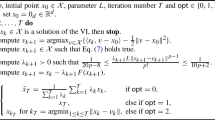Abstract
We consider a class of problems of resource allocation under economies of scale, namely that of minimizing a lower semicontinuous, isotone, and explicitly quasiconcave cost function subject to linear constraints. An important class of algorithms for the linearly constrained minimization of nonconvex cost functions utilize the branch and bound approach, using convex underestimating cost functions to compute the lower bounds.
We suggest instead the use of the surrogate dual problem to bound subproblems. We show that the success of the surrogate dual in fathoming subproblems in a branch and bound algorithm may be determined without directly solving the surrogate dual itself, but that a simple test of the feasibility of a certain linear system of inequalities will suffice. This test is interpreted geometrically and used to characterize the extreme points and extreme rays of the optimal value function's level sets.
Similar content being viewed by others
References
S. Agmon, “The relaxation method for linear inequalities”,Canadian Journal of Mathematics 6 (1954) 382–392.
D. Bricker and T.S. Chang, “A surrogate dual for the plant location problem”,SCIMA 7 (1978) 16–26.
A. Cabot, “Variations on a cutting plane method for solving concave minimization problems with linear constraints”,Naval Research Logistics Quarterly 21 (1974) 265–274.
M. Carrillo, “A relaxation algorithm for the minimization of a quasiconcave function on a convex polyhedron”,Mathematical Programming 13 (1977) 69–80.
J. Falk, “Lagrange multipliers and nonconvex programs”,SIAM Journal of Control 7 (1969) 534–545.
J. Falk, “An algorithm for locating approximate global solutions of nonconvex, separable problems”, Technical Paper T-262, Program in Logistics, George Washington University Washington, D.C. (1972).
J. Falk and K. Hoffman, “A successive underestimation method for concave minimization problems”,Mathematics of Operations Research 1 (1976) 251–259.
J. Falk and J. Horowitz, “Critical path problems with concave cost-time curves”,Management Science 19 (1972) 446–455.
J. Falk and R. Soland, “An algorithm for separable nonconvex programming problems”,Management Science 15 (1969) 550–562.
Harvey J. Greenberg, “Lagrangian duality gaps: their source and resolution”, Tech. Rept. CP-69005, Southern Methodist University (1969).
Harvey J. Greenberg, and W.P. Pierskalla, “Surrogate mathematical programming”,Operations Research 18 (1970) 924–939.
Harvey J. Greenberg and W.P. Pierskalla, “Quasi-conjugate functions and surrogate duality”,Cahiers du Centre l'Études de Recherche Operationelle 15 (1973) 437–448.
R. Horst, “An algorithm for nonconvex programming problems”,Mathematical programming 10 (1976) 312–321.
R. Horst, “A new branch and bound approach for concave minimization problems”, in: Jean Cea, ed.,Optimization techniques II, IFIP Conference on Optimization Techniques, Nice, 1975 (Springer, Berlin, 1976).
A. Jones and R. Soland, “A branch and bound algorithm for multi-level fixed charge problems”,Management Science 16 (1969) 67–76.
B. Martos,Nonlinear programming theory and methods (North-Holland, Amsterdam, 1975) Ch. 5.
G.P. McCormick, “Attempts to calculate global solutions of problems that may have local minima”, in: F.A. Lootsma, ed.,Numerical methods for nonlinear optimization (Academic Press, New York, 1972) pp. 209–221.
P. Rech and L.G. Barton, “A non-convex transportation algorithm”, in: E.M.L. Beale, ed.,Applications of mathematical programming techniques (American Elsevier, New York, 1970).
R.T. Rockafellar,Convex analysis (Princeton University Press, Princeton, NJ, 1970).
R.M. Soland, “An algorithm for separable piecewise convex programming problems”, Research Report CS60, Center for Cybernetics Studies, University of Texas (August 1971).
R.M. Soland, “Optimal facility location with concave costs”,Operations Research 22 (1974) 373–382.
H.A. Taha, “Concave minimization over a convex polyhedron”,Naval Research Logistics Quarterly 20 (1973) 533–548.
H. Tui, “Concave programming under linear constraints”,Soviet Mathematics 5 (1964) 1437–1400.
P.B. Zwart, “Global maximization of a convex function with linear inequality constraints”,Operations Research 22 (1974) 602–609.
Author information
Authors and Affiliations
Additional information
Research partially supported by NSF under grant # ENG77-06555.
Rights and permissions
About this article
Cite this article
Bricker, D.L. Bounding a class of nonconvex linearly-constrained resource allocation problems via the surrogate dual. Mathematical Programming 18, 68–83 (1980). https://doi.org/10.1007/BF01588298
Received:
Revised:
Issue Date:
DOI: https://doi.org/10.1007/BF01588298




